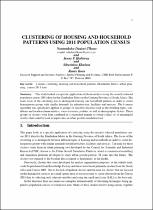JavaScript is disabled for your browser. Some features of this site may not work without it.
- ResearchSpace
- →
- Research Publications/Outputs
- →
- Conference Publications
- →
- View Item
| dc.contributor.author |
Dudeni-Tlhone, N

|
|
| dc.contributor.author |
Holloway, Jennifer P

|
|
| dc.contributor.author |
Khuluse, S

|
|
| dc.contributor.author |
Koen, Renée

|
|
| dc.date.accessioned | 2014-01-24T10:12:46Z | |
| dc.date.available | 2014-01-24T10:12:46Z | |
| dc.date.issued | 2013-11 | |
| dc.identifier.citation | Dudeni-Tlhone, N, Holloway, J.P, Khuluse, S and Koen, R. 2013. Clustering of housing and household patterns using 2011 population census. In: 55th Annual Conference of the South African Statistical Association, University of Limpopo, Polokwane, Limpopo Province, South Africa, 4-8 November 2013 | en_US |
| dc.identifier.uri | http://hdl.handle.net/10204/7174 | |
| dc.description | 55th Annual Conference of the South African Statistical Association, University of Limpopo, Polokwane, Limpopo Province, South Africa, 4-8 November 2013 | en_US |
| dc.description.abstract | This study looked at a specific application of cluster analysis using the recently released population census 2011 data for the Ekurhuleni Metro in the Gauteng Province of South Africa. The main focus of the clustering was to distinguish housing and household patterns in order to create homogenous groups with similar demands for infrastructure, facilities and services. The k-means algorithm was specifically applied to groups of variables (factors) such as the dwelling types, conditions and location characteristics, socio-economic profiles, as well as demographic factors. These groups of clusters were later combined in a sequential manner to obtain a final set of meaningful clusters that could be used as inputs into an urban growth simulation tool. | en_US |
| dc.language.iso | en | en_US |
| dc.relation.ispartofseries | Workflow;11986 | |
| dc.subject | K-means clustering | en_US |
| dc.subject | Housing patterns | en_US |
| dc.subject | Household patterns | en_US |
| dc.subject | Urban planning | en_US |
| dc.subject | Ekurhuleni Metro | en_US |
| dc.subject | Census 2011 data | en_US |
| dc.title | Clustering of housing and household patterns using 2011 population census | en_US |
| dc.type | Conference Presentation | en_US |
| dc.identifier.apacitation | Dudeni-Tlhone, N., Holloway, J. P., Khuluse, S., & Koen, R. (2013). Clustering of housing and household patterns using 2011 population census. http://hdl.handle.net/10204/7174 | en_ZA |
| dc.identifier.chicagocitation | Dudeni-Tlhone, N, Jennifer P Holloway, S Khuluse, and Renée Koen. "Clustering of housing and household patterns using 2011 population census." (2013): http://hdl.handle.net/10204/7174 | en_ZA |
| dc.identifier.vancouvercitation | Dudeni-Tlhone N, Holloway JP, Khuluse S, Koen R, Clustering of housing and household patterns using 2011 population census; 2013. http://hdl.handle.net/10204/7174 . | en_ZA |
| dc.identifier.ris | TY - Conference Presentation AU - Dudeni-Tlhone, N AU - Holloway, Jennifer P AU - Khuluse, S AU - Koen, Renée AB - This study looked at a specific application of cluster analysis using the recently released population census 2011 data for the Ekurhuleni Metro in the Gauteng Province of South Africa. The main focus of the clustering was to distinguish housing and household patterns in order to create homogenous groups with similar demands for infrastructure, facilities and services. The k-means algorithm was specifically applied to groups of variables (factors) such as the dwelling types, conditions and location characteristics, socio-economic profiles, as well as demographic factors. These groups of clusters were later combined in a sequential manner to obtain a final set of meaningful clusters that could be used as inputs into an urban growth simulation tool. DA - 2013-11 DB - ResearchSpace DP - CSIR KW - K-means clustering KW - Housing patterns KW - Household patterns KW - Urban planning KW - Ekurhuleni Metro KW - Census 2011 data LK - https://researchspace.csir.co.za PY - 2013 T1 - Clustering of housing and household patterns using 2011 population census TI - Clustering of housing and household patterns using 2011 population census UR - http://hdl.handle.net/10204/7174 ER - | en_ZA |






